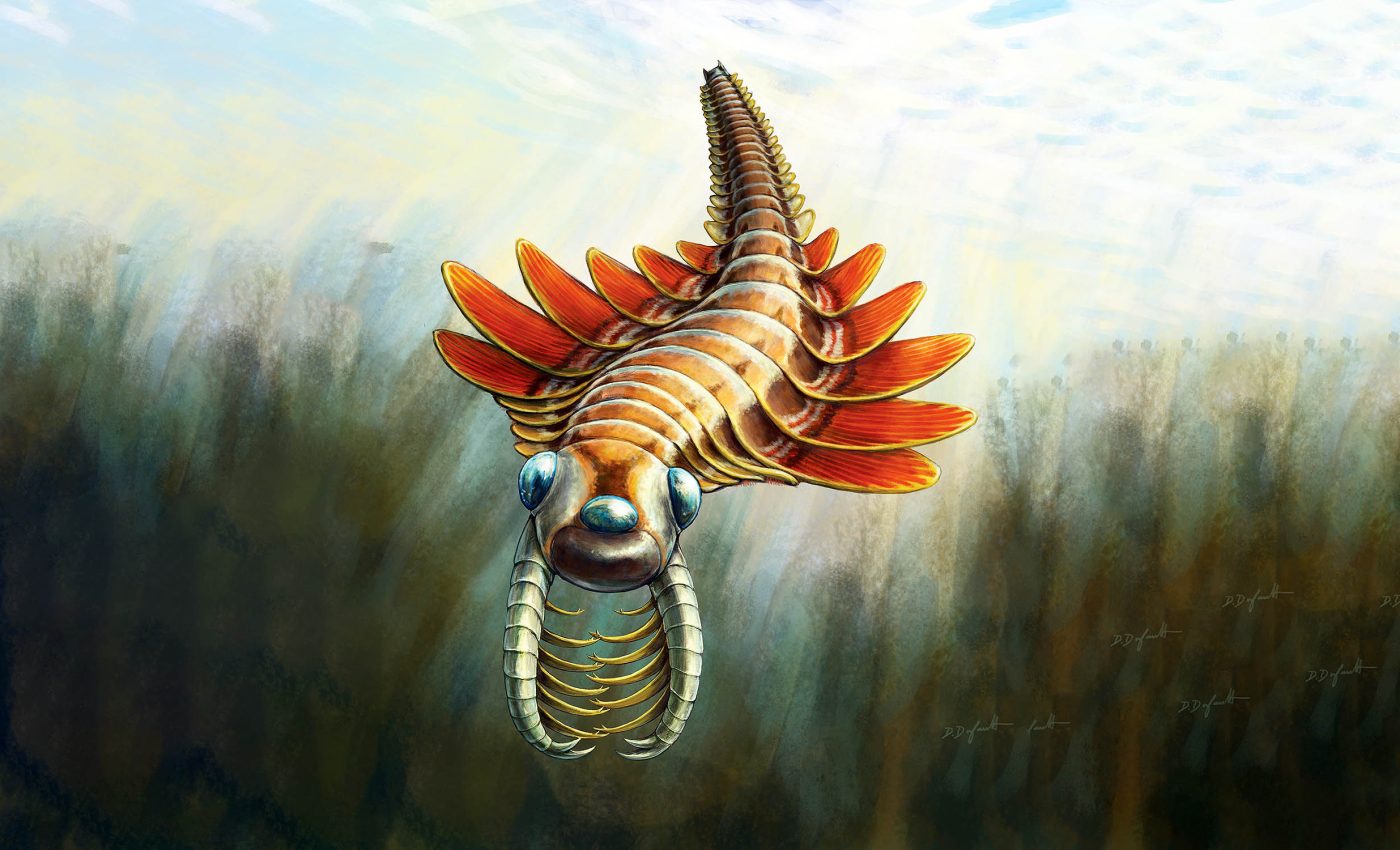
506-million-year-old predator used to swim the Cambrian seas
Paleontologists have identified a new finger-sized hunter from the Cambrian seas, whose fossils preserve eyes, nerves, gut, and even traces of blood.
The creature, named Mosura fentoni, prowled Canadian waters 506 million years ago and shows that early arthropods were diversifying in unexpected ways.
Arthropod fossil found in Rockies
The research comes from an international team working with the Manitoba Museum and the Royal Ontario Museum (ROM).
Over nearly five decades, collectors retrieved sixty-one specimens from Yoho and Kootenay National Parks.
Most were lifted from Raymond Quarry; others came from the Marble Canyon area, which has yielded a flurry of spectacular Burgess Shale fossils.
The new study adds a fresh branch to the extinct radiodonts, a group that already includes the meter-long apex predator Anomalocaris.
Tiny Mosura fentoni was a predator
Mosura measured roughly the length of an index finger. Its head carried three eyes and a circular, toothed mouth. Jointed, spiny claws jutted forward to snatch prey, while broad swimming flaps rippled down each side of the body.
Collectors nicknamed it the “sea-moth” because the midsection flaps and narrow tail suggested the silhouette of a hovering moth, a nod later echoed in the formal genus name, which references the Japanese film monster Mothra.
An unexpected abdomen
Radiodonts normally finish with a short, paddle-like tail, but Mosura breaks this pattern. “Mosura has sixteen tightly packed segments lined with gills at the rear end of its body,” said study leader Joe Moysiuk, Curator of Palaeontology and Geology at the Manitoba Museum.
“This is a neat example of evolutionary convergence with modern groups, like horseshoe crabs, woodlice, and insects, which share a batch of segments bearing respiratory organs at the rear of the body,”
The extra segments may have boosted oxygen uptake, hinting at a lifestyle or habitat that demanded efficient respiration, though the exact advantage remains unknown.
Nerves preserved in Mosura fentoni
Few places on Earth preserve soft anatomy as well as the Burgess Shale, and Mosura takes full advantage of that rarity.
“Very few fossil sites in the world offer this level of insight into soft internal anatomy,” said co-author Jean-Bernard Caron, Curator of Invertebrate Palaeontology at ROM.
“We can see traces representing bundles of nerves in the eyes that would have been involved in image processing – just like in living arthropods. The details are astounding.”
The arthropod fossils also capture reflective patches that fill the trunk and extend into the flaps. These mark blood spaces, or lacunae, part of an ancient open circulatory system.
“The well-preserved lacunae of the circulatory system in Mosura help us to interpret similar but less clear features that we’ve seen before in other fossils. Their identity has been controversial,” added Moysiuk, who is also a research associate at ROM.
“It turns out that preservation of these structures is widespread, confirming the ancient origin of this type of circulatory system.”
First arthropods surprised scientists
Radiodonts occupy the deepest branch on the arthropod family tree – well before the lineages that lead to spiders, insects, or crabs.
“Radiodonts were the first group of arthropods to branch out in the evolutionary tree, so they provide key insight into ancestral traits for the entire group,” Caron explained.

“The new species emphasizes that these early arthropods were already surprisingly diverse and were adapting in a comparable way to their distant modern relatives.”
The convergent abdomen of Mosura suggests that complex body regions bearing gills evolved more than once, long before insects or crustaceans refined the same solution.
A fossil treasure trove
Of the sixty-one known specimens, all but one were collected by ROM teams between 1975 and 2022. The lone outlier was recovered a century earlier by Charles Walcott, discoverer of the Burgess Shale itself.
“Museum collections, old and new, are a bottomless treasure trove of information about the past. If you think you’ve seen it all before, you just need to open a museum drawer,” Moysiuk said.
Parks Canada manages the fossil sites and guides visitors on award-winning hikes. The Burgess Shale gained UNESCO World Heritage status in 1980 and now forms part of the broader Canadian Rocky Mountain Parks listing.
Mosura fentoni expands early life story
Specimens of many radiodonts, including the new “sea-moth,” are on display in Toronto’s Willner Madge Gallery: Dawn of Life, while Mosura will make its public debut in Winnipeg later this year.
As curators prepare those showcases, researchers continue sifting through Burgess Shale slabs for still-undiscovered species. Each one fills another gap in the early history of animals, clarifying how complex bodies, limbs, and organ systems evolved.
The finger-sized Mosura fentoni reminds us that even the smallest arthropod fossil can overturn assumptions about life half a billion years ago – and that the archives of museums still hold many secrets waiting to be discovered.
The study is published in the journal Royal Society Open Science.
—–
Like what you read? Subscribe to our newsletter for engaging articles, exclusive content, and the latest updates.
Check us out on EarthSnap, a free app brought to you by Eric Ralls and Earth.com.
—–













